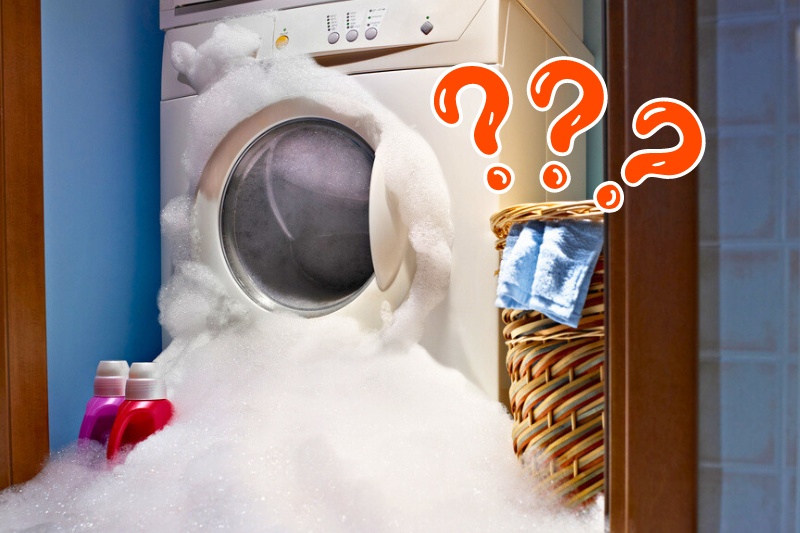You might think that seeing lots of foam in the washing machine means that the clothes are having a really good clean in the drum. But, unfortunately, that’s not the case. When there’s too much foam in the washing machine, the laundry isn’t cleaned effectively.
In fact, the dirty washing gets coated in suds, doesn’t get agitated in the drum because it’s essentially wrapped in a blanket of foam, and doesn’t end up clean because you need friction, as well as adequate soap and water to remove stains!
What’s more, if the machine can’t handle the foam inside the appliance, it’ll start to leak out of the washer’s drawer. As you can imagine, it’s not great, and it can be a lot of work to rectify this foamy issue.
But before you can right the wrongs, you need to know why the machine is filling up with an excessive amount of foam so you can stop the problem from occurring again. Read on to learn more.
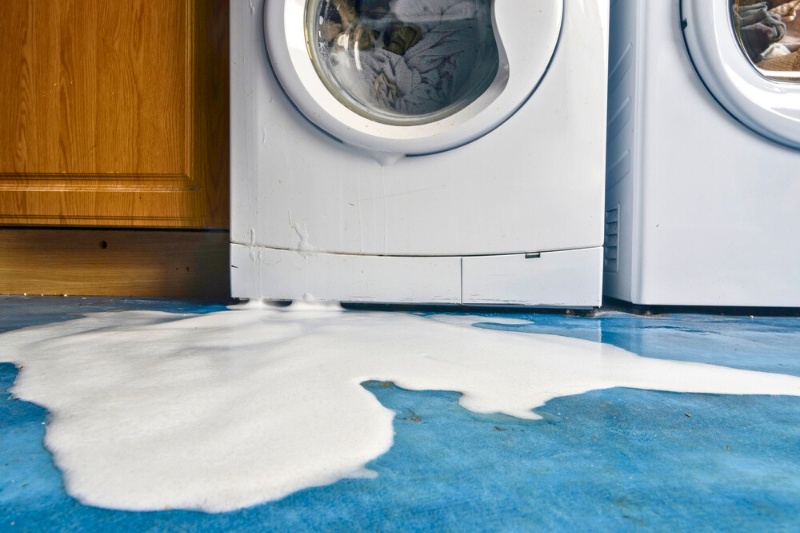
Why Is the Washing Machine Leaking Foam?
Got a load of suds piling up in front of the washer? You’re probably wondering what on earth the sudsy mess is doing there.
There are many reasons why foam leaks out of a washing machine. These include:
1. Too much detergent has been added to the washing machine
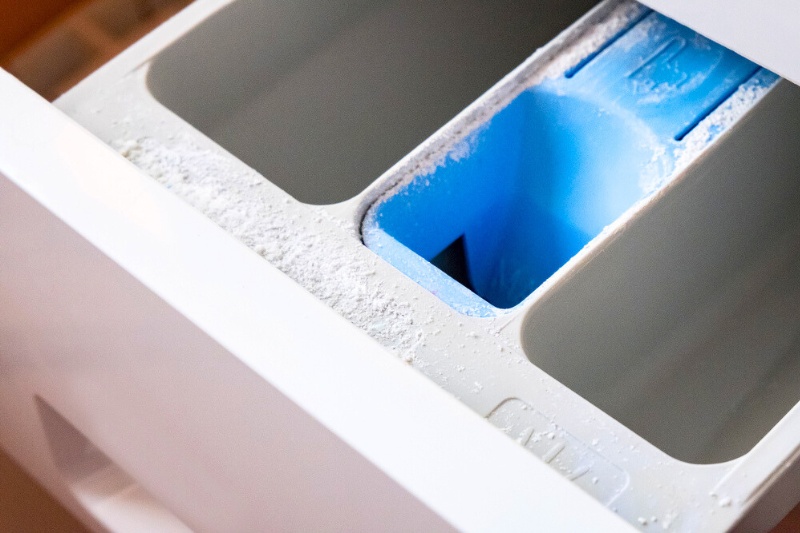
It’s very easy to blame the washing machine for the excess foam. However, user error is normally at fault. Yep, you, the user, essentially overdosed the washing machine with cleaning solution. In turn, you’ve got a mass of foam.
Solution: Stick to the dose stipulated on the detergent’s packaging.
If you need to adjust the dose, for example to clean extra soiled clothes or if you live in a hard water area, stick to the instructions on the packaging. Don’t guess and put a random amount of cleaner in the washing machine.
2. There’s a build-up of detergent in the machine

If you constantly add too much detergent to the washing machine, eventually, you’ll get a build-up of cleaner.
In addition, perhaps the water inside the washing machine isn’t hot enough, so the detergent isn’t flushed through the system and used effectively. Consequently, some detergent residue is left behind and builds up over time.
Solution: Run an empty cycle through the machine to flush out the detergent build-up.
In addition, make a habit of cleaning the detergent drawer on your washing machine. You don’t want gunk to build-up in the area.
3. The type of water going into your washing machine
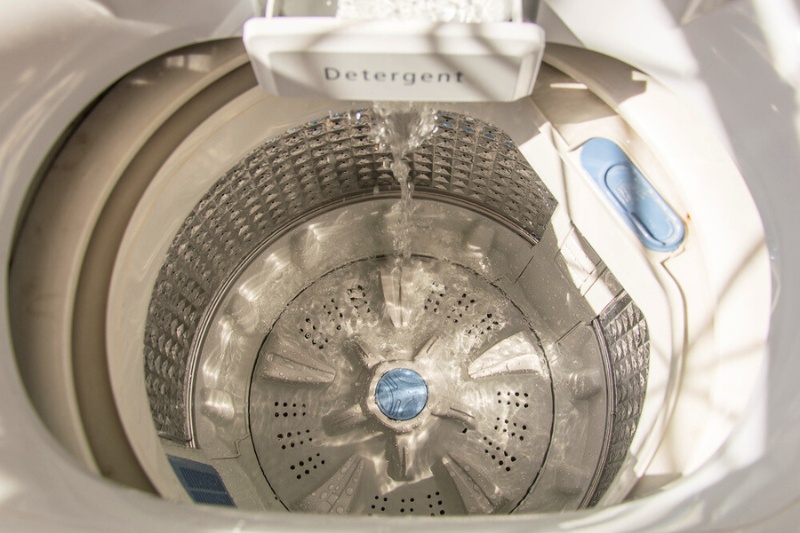
If you believe that you live in a hard water area, but you actually don’t, you may be adding additional detergent to your washing machine every time you clean clothes to compensate for the “higher mineral content” in the water.
In reality, there’s no need for you to add extra detergent because the water is soft enough. By mixing soft water with too much detergent, you create foam.
Solution: Check the water hardness in your area and adjust the dose of detergent to suit the water.
In soft water areas, you might not have to use as much detergent anyway – always check the detergent’s packaging for more guidance.
4. Water-softening products could be doing more harm than good
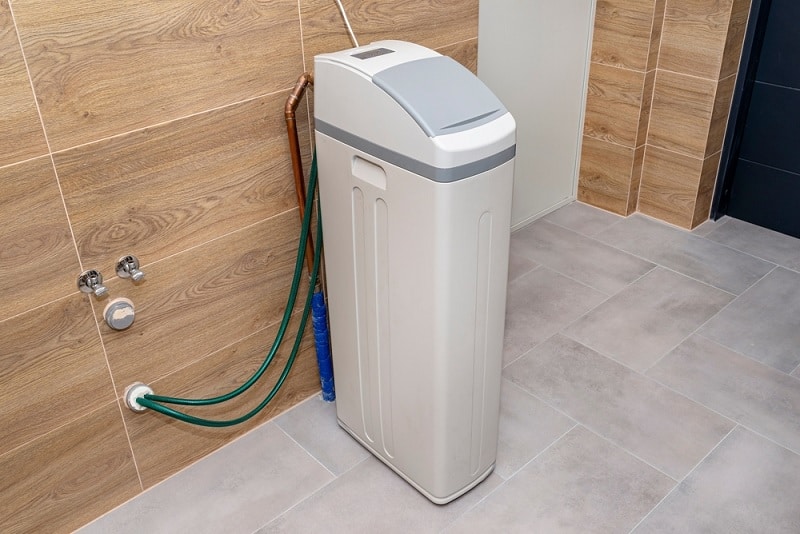
As above, if you’re adding stuff to your water to make it soft, you could be doing more harm than good. Again, the water softener and detergent will mix and create foam.
Solution: Adjust the dose of detergent to suit the water going into your washing machine.
5. The machine is broken or malfunctioning
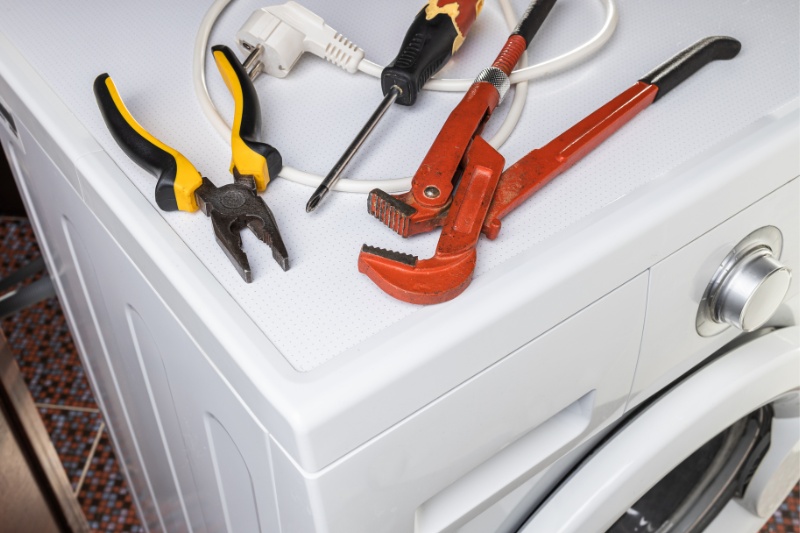
If foam leaks from your washing machine when your appliance is running through its rinse and spin cycle, this is a tell-tale sign of a problem with the machine.
The issue in question could be something simple, like a blocked drain, hose or filter, but it could also be something bigger, like a malfunctioning pump.
A lot of dirt can get wedged into these small spaces, things like tissues, sweets and coins. If these obstructions aren’t removed, they can cause severe problems that can lead to foaming.
Solution: Clean the parts mentioned above and make sure they’re not blocked or broken. After washing each section, the appliance should work effectively. If parts are visibly damaged, they will need to be replaced.
6. A hand wash-only detergent has been added to the washing machine
As a consequence of adding the wrong type of detergent to the machine, you may get lots of suds running out of the machine.
In addition, sometimes, using low-quality detergent can cause an explosion of foam inside a washing machine. This problem can escalate if you also add too much of this rubbish detergent to the appliance!
On the topic of adding the wrong cleaner to the machine, don’t add alternatives like washing-up liquid, bubble bath, and shampoo to the appliance. Items like the ones mentioned are not designed to go inside a washing machine.
If they’re put in the machine, they will create suds and scum. You’ll then have to run several empty rinses to remove the residue from the machine. Running so many cycles will be expensive and a waste of energy.
Solution: Ensure you buy a suitable detergent, in this case, a quality cleaner that can be used in a washing machine.
Always double-check what detergent you put inside the machine if you have multiple detergents at home.
7. A blocked detergent drawer

Water and detergent cannot flow through the machine effectively if your detergent drawer is clogged up. Consequently, you end up with a build-up of suds.
Solution: Remove and clean the detergent drawer. You can brush the gunk away using hot water and a soft toothbrush.
8. The washing machine is overloaded
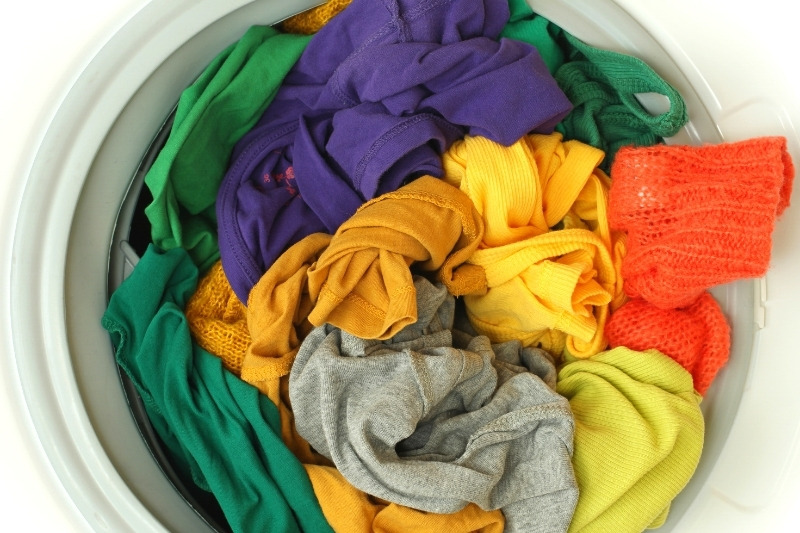
If you overload your washing machine with laundry, the clothes inside the drum won’t be agitated and spun around effectively. In turn, the suds won’t be able to escape from the machine, so you’ll see lots of foam inside the machine.
Solution: Check the capacity guide on your washer and only add a certain amount of clothes to the machine. Adding the correct amount of laundry to the drum will give the items ample room to move around and be rinsed effectively in the drum.
What to Do If There’s Foam Coming Out of Your Washing Machine

Here are some steps you can take if you’ve got foam in/coming out of the washing machine:
- Run an empty, detergent-free cycle through the washing machine to remove the foam. You may have to repeat this process to remove all the suds from the machine.
- Start an extra rinse cycle if you don’t want the machine to go through a normal washing cycle again. The rinse cycle will be able to remove a lot of the foam that’s trapped inside the machine, but you may have to repeat this step more than once to eradicate all the foamy residue.
- Clean the drain, hose, filter and pump on your washing machine. If you’re not sure where these parts are or how to access them, read your user manual. The manual will also stipulate how to clean each part correctly so you don’t cause further damage.
- Run a maintenance wash/self-clean cycle through the machine to remove the foam and wash the appliance thoroughly (the machine must be empty – no clothes in the drum). If you don’t have a self-clean cycle, run the hottest cycle possible; this is usually a cotton one that’s about 90°C.
- Clean the machine with a washing machine cleaner to remove foamy residue.
- In addition to ensuring the washing machine is foam-free, you must re-clean your clothes because they will be coated in detergent.
- If you notice foam forming in the washing machine, add a dose of fabric softener to the appliance just before the rinse cycle. The softener can help to calm the foamy situation.
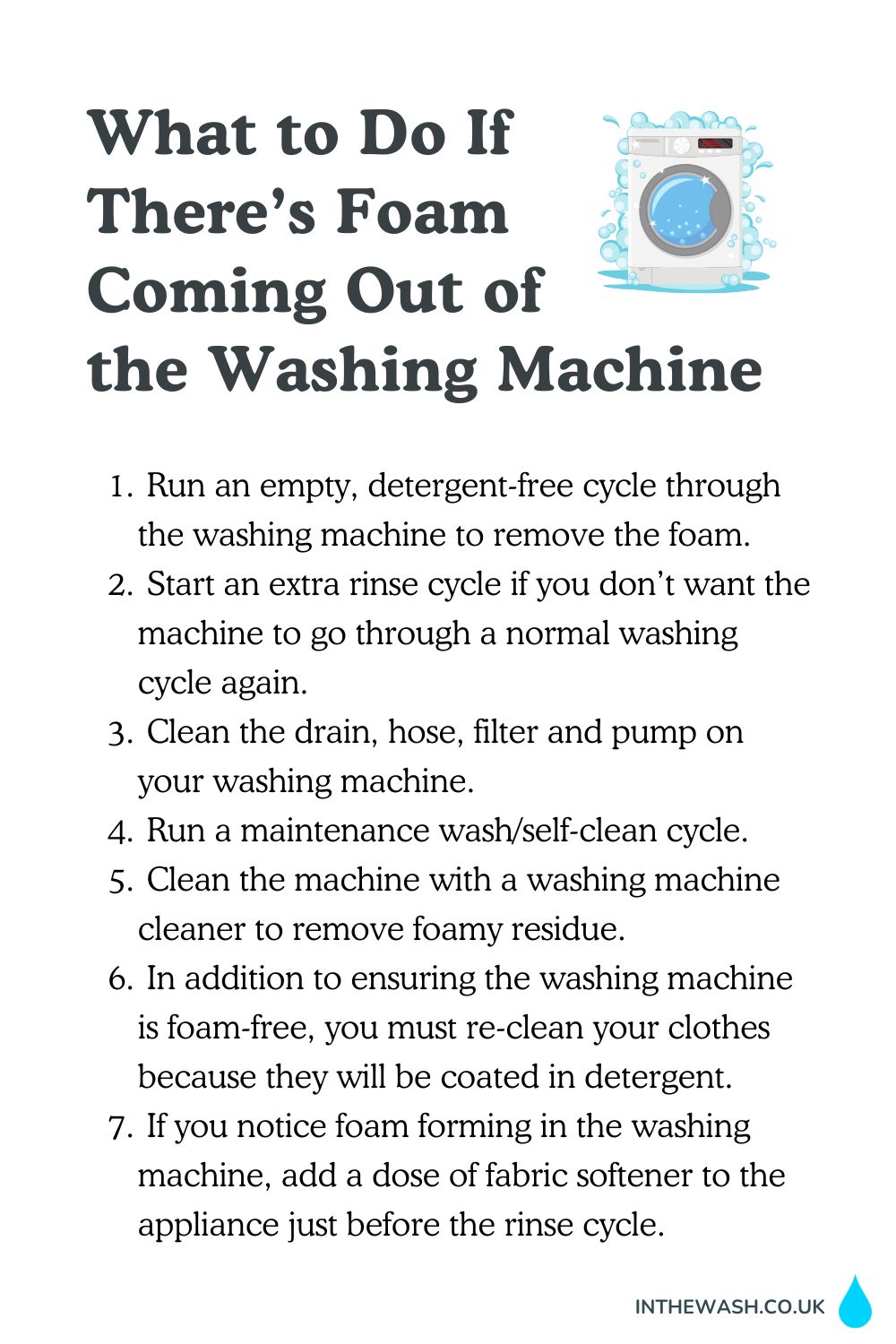
For future reference, you should:
- Make sure you stick to dosage instructions on the detergent’s packaging. If you find it challenging to stick to the dose stipulated, use a type of detergent that has been pre-measured for you, like laundry pods or detergent sheets.
- Switch detergents if you experience a foamy problem every time you use a certain kind of detergent.
- Make sure you use the right cycles to clean your clothes.
- Contact the manufacturer or call an engineer to assess the machine if the foam-related problem persists. There could be an issue with the machine, which can explain why an excess of foam is coming out of the machine.
Can Too Much Foam Break a Washing Machine?
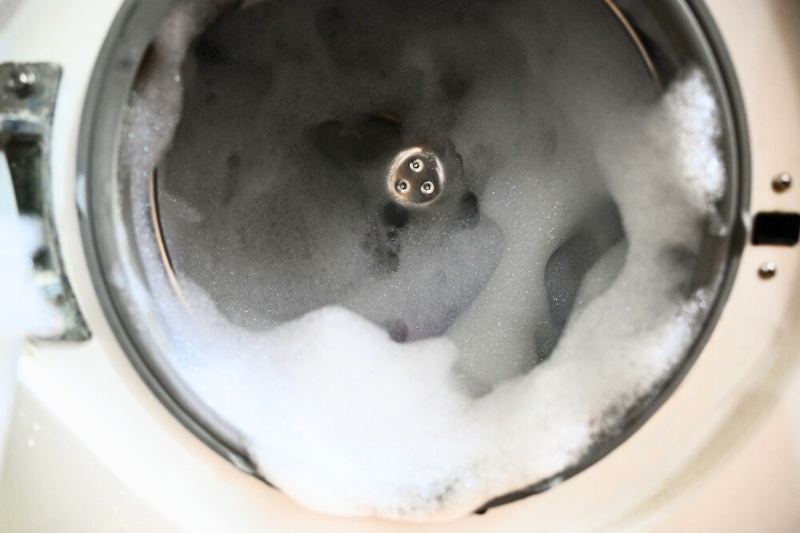
If a washing machine is consistently exposed to vast quantities of foam, the appliance will sustain damage.
Foam can cause a number of problems. The most common include:
- Drainage problems.
- Parts within the appliance will sustain damage, like the pump, thermostat, and sensors. Consequently, they will malfunction or become defective.
- Warning and safety precautions will be triggered, thus disrupting cycles.
- Corrosion may occur over time.
- Leaks and external damage to the areas around the washing machine, like the floor and walls, can occur.
If a washing machine is subjected to too much foam over a period of time, a few or most of the problems listed above will start to pop up. Consequently, the washing machine will start to deteriorate, and its lifespan will be cut short.
Always follow the steps above to prevent a build-up of foam in your washing machine.

Bethan has a passion for exploring, reading, cooking and gardening! When she’s not creating culinary delights for her family, she’s concocting potions to keep her house clean!
